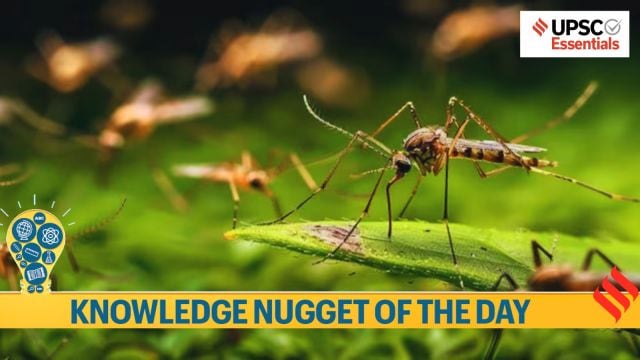
Why in the news?
The Indian Council of Medical Research (ICMR) has invited the country’s vaccine manufacturers to partner with it to launch and sell a malaria vaccine, AdFalciVax, that its Regional Medical Research Centre, Bhubaneshwar, has developed. In this context, let’s know about this new vaccine and malaria.
Key Takeaways :
1. AdFalciVax is a chimeric recombinant vaccine — a type of vaccine that uses different parts of the genes of a pathogen (in this case, Plasmodium) to create target proteins that trigger an immune response after being injected.
2. AdFalciVax uses two types of target proteins to prevent the spread of infection in two different ways.
↪ It uses the circumsporozoite protein (CSP) to prevent infection in the person who has been immunised. The CSP is produced during the sporozoite stage (when a parasite can infect a new host) and the liver stage (when a parasite enters liver cells, multiplies, and then infects red blood cells) of the parasite.
“Any immune response generated against these stages protects the immunised person from getting the infection.” Subhash Singh, project manager for development of the vaccine at the ICMR-Regional Medical Research Centre, Bhubaneswar told The Indian Express.
Story continues below this ad
↪ The vaccine also uses the Pro6C protein, a fusion of parts of two different proteins — Pfs230 and Pfs48/45 — produced by Plasmodium falciparum. This protein prevents the spread of infection in the community.
3. Researchers have found that AdFalciVax provided more than 90% protection against infection in mice. The candidate vaccine has yet to undergo rigorous human trials, and the preliminary results have been obtained only through testing on animals.
UPSC ESSENTIALSICMR’s candidate vaccine- A new hope in the fight against malaria
To combat malaria, scientists have been working to develop a vaccine for decades but with limited success. Recently, two vaccines—RTS,S and R21—were approved for use, but their efficacy, at 75%, is quite low. That’s why the announcement about ICMR’s candidate vaccine has given new hope in the fight against the disease.
4. The ICMR wants to partner with a company that can further develop its candidate vaccine, carry out human clinical trials, and scale up for commercial production. Although the ICMR will share the technology of developing AdFalciVax with the chosen company, it will continue to hold the intellectual property rights. Any intellectual property rights generated during the collaboration will be held jointly by the ICMR and the company.
5. Notably, AdFalciVax mainly targets two parts of Plasmodium falciparum, a pathogen that is the most common source of malaria in humans. In India, however, the disease is caused by Plasmodium vivax against which AdFalciVax is ineffective.
Story continues below this ad
- 01
What is the theme of World Malaria Day 2025?
World Malaria Day is observed every year on 25th April by the World Health Organisation to raise awareness and drive action against malaria. The theme for World Malaria Day 2025 is “Malaria Ends With Us: Reinvest, Reimagine, Reignite.”
Malaria
1. Having claimed millions of lives, malaria has been one of the deadliest diseases in human history. Currently, the disease kills about four lakh people annually, according to World Health Organization (WHO) figures.
2. Malaria is a parasitic infection transmitted by mosquitoes, typically causing symptoms such as fever, chills, night sweats, nausea, vomiting, and diarrhoea. In some cases, it can lead to severe complications such as seizures, fluid in the lungs, organ damage, and death.
3. It is most endemic in Africa — Nigeria, Congo, Tanzania, Mozambique, Niger, and Burkina Faso together account for more than half the yearly deaths.
BEYOND THE NUGGET: What does the World Malaria Report 2024 say about malaria in India?
1. India has demonstrated significant progress in reducing malaria cases and associated mortality in the country’s high-endemic states, according to the findings of the World Health Organisation’s (WHO) ‘World Malaria Report 2024′.
Story continues below this ad
2. “India exited the HBHI [high-burden to high-impact] group officially in 2024 due to significant progress in reducing the malaria incidence and mortality observed in its high-endemic states,” the report observed.
3.“Nationwide, the number of estimated malaria cases in India decreased from 6.4 million in 2017 (the year before the HBHI’s introduction) to 2 million cases in 2023 (69 per cent decrease). Similarly, the estimated malaria deaths decreased from 11,100 to 3,500 (68 per cent decrease) during the same period,” it said.
4. The HBHI refers to a targeted WHO initiative aimed at the most acutely malaria-impacted regions of the world, including several countries in Africa.
Post Read Question
Widespread resistance of malarial parasite to drugs like chloroquine has prompted attempts to develop a malarial vaccine to combat malaria. Why is it difficult to develop an effective malaria vaccine? (UPSC CSE 2010)
(a) Malaria is caused by several species of Plasmodium
Story continues below this ad
(b) Man does not develop immunity to malaria during natural infection
(c) Vaccines can be developed only against bacteria
(d) Man is only an intermediate host and not the definitive host
🚨 Click Here to read the UPSC Essentials magazine for July 2025. Share your views and suggestions in the comment box or at manas.srivastava@indianexpress.com🚨


































